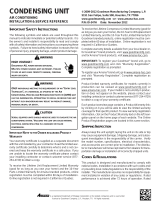
4
Refrigerant Line Connections
NOTICE
THIS UNIT IS SHIPPED WITH A NITROGEN/HELIUM
HOLDING CHARGE ONLY. UNIT MUST BE EVACUATED
AND CHARGED PER INSTALLATION INSTRUCTIONS
WITH REFRIGERANT LISTED ON SERIAL RATING PLATE.
NOTICE
UNITS SHIPPED WITH A HOLDING CHARGE ARE
INTENDED FOR COMPONENT REPLACEMENT ONLY ON
EXISTING SYSTEMS, AND NOT INTENDED FOR USE IN
NEW SYSTEMS OR NEWLY CONSTRUCTED HOMES.
EPA REGULATIONS PROHIBIT THE SALE OR
DISTRIBUTION OF APPLIANCES PRE-CHARGED WITH
THE REFRIGERANT R-22 IF THOSE APPLIANCES ARE
MANUFACTURED AFTER JANUARY 1, 2010.
COMPONENTS OF EXISTING R-22 SYSTEMS MAY BE
REPAIRED AND/OR REPLACED.
NOTICE
UNITS MUST ONLY BE USED AS REPLACEMENT
COMPONENTS FOR PRE-2010 INSTALLED SYSTEMS.
NOTE: Holding charge must be removed before brazing. Open
service valves slowly to remove holding charge. Close valves
before brazing to prevent contaminants from entering system.
IMPORTANT
To avoid overheating the service valve, TXV valve, or filter
drier while brazing, wrap the component with a wet rag, or
use a thermal heat trap compound. Be sure to follow the
manufacturer’s instruction when using the heat trap
compound. Note: Remove Schrader valves from service
valves before brazing tubes to the valves. Use a brazing
alloy of 2% minimum silver content. Do not use flux.
Torch heat required to braze tubes of various sizes is
proportional to the size of the tube. Tubes of smaller size
require less heat to bring the tube to brazing temperature
before adding brazing alloy. Applying too much heat to
any tube can melt the tube. Service personnel must use
the appropriate heat level for the size of the tube being
brazed. Note: The use of a heat shield when brazing is
recommended to avoid burning the serial plate or the finish
on the unit.
1. The ends of the refrigerant lines must be cut square, de-
burred, cleaned, and be round and free from nicks or dents.
Any other condition increases the chance of a refrigerant
leak.
2. “Sweep” the refrigerant line with nitrogen or inert gas dur-
ing brazing to prevent the formation of copper-oxide in-
side the refrigerant lines. This may cause a blockage or
failure of the metering device.
3. After brazing, quench the joints with water or a wet cloth
to prevent overheating of the service valve.
4. Ensure the filter drier paint finish is intact after brazing. If
the paint of the steel filter drier has been burned or chipped,
repaint or treat with a rust preventative. This is especially
important on suction line filter driers which are continu-
ally wet when the unit is operating.
NOTE: Be careful not to kink or dent refrigerant lines. Kinked
or dented lines will cause poor performance or compressor
damage.
Do NOT make final refrigerant line connection until plugs are
removed from refrigerant tubing.
NOTE: Before brazing, verify indoor piston size by checking
the piston kit chart packaged with indoor unit.
Leak Testing (Nitrogen or Nitrogen-Traced)
To avoid the risk of fire or explosion, never use
oxygen, high pressure air or flammable gases for leak
testing of a refrigeration system.
WARNING
To avoid possible explosion, the line from the
nitrogen cylinder must include a pressure regulator
and a pressure relief valve. The pressure relief valve
must be set to open at no more than 150 psig.
WARNING
Pressure test the system using dry nitrogen and soapy water
to locate leaks. If you wish to use a leak detector, charge the
system to 10 psi using the appropriate refrigerant then use
nitrogen to finish charging the system to working pressure then
apply the detector to suspect areas. If leaks are found, repair
them. After repair, repeat the pressure test. If no leaks exist,
proceed to system evacuation.
System Evacuation
Condensing unit liquid and suction valves are closed. The unit
is shipped with the valve stems closed and caps installed.
REFRIGERANT UNDER PRESSURE!
Failure to follow proper procedures may cause
property damage, personal injury or death.
WARNING
NOTE: Scroll compressors should never be used to evacuate
or pump down a heat pump or air conditioning system.





















